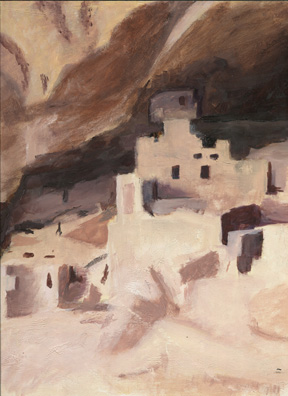Mesa Verde

The homes of the Anasazi. No one knows where they came from or where they went. That they assimilated into other tribes like the Hopi and the Navajo is as good a guess as any.
This is actually a sketch - in oil paints and realizing "sketch" refers to the degree of finish and not necessarily the time required - of the cliff dwellings that were inhabited 1150 - 1350 A. D. What is interesting is that if you use what is called the Sugarscape model but based on the availability of water you end up having the inhabitants end up in the areas of the ruins. "Ruins", though, is not really an apt term as many are very well preserved. The cliff dwellings shown here were those discovered on December 18, 1888, by two cowboys. Over two days they discovered two more sites which didn't become tourist sites for decades.
However, it's best not to claim that the Sugarscape program "predicts" the final areas of Anasazi dwellings. After all we already knew where they were. If you predict something that's already happened, that's not really predicting. And the scientists who did the work made no such claim.
Why, you wonder, do we call the Greeks, the Egyptians, the Canaanites, and the Maya civilizations, but not the Iroquois, the Hopi, or, yes, the Anasazi? Some people will say it's because they had no central government (neither did the Greeks), the settlements were too small (some "kings" of the Canaanites may have ruled a couple of hundred people), or had no written constitution (neither did the Greeks, Canaanites, Rome, or present-day England).
No, western societies have tended to lump societies as "civilizations" if they had a writing system. We're not saying that's right, but that's they way it's been done.
The rendering of the Mesa Verde ruins is an oil sketch using not just oils but water miscible oils. These are oil paints which also contain what are called compatibilizing agents. Compatibilizing agents (or emulsifying agents) are similar to detergents but generally the molecules aren't as big and the differences in the separate groups of the molecules - the "hydrophobic" and the "hydrophilic" groups - aren't as extreme.
A Personal CooperToons Opinion is that the water mixable oils have definite advantages. Obviously one is being water mixable. You can clean them up in water and you can thin the paint with water. On the other hand, they don't seem to have the flow characteristics of traditional oil paint. They are more "pasty" and don't spread over the canvass as easily. Still, they are pretty good and will probably get better and the paint manufacturers do more and more development work.
Reference
The Prehistoric Pueblo World: A.D. 1150-1350, Michael Adler, University of Arizona Press, 2000.
"Population Growth and Collapse in a Multiagent Model of the Kayenta Anasazi in Long House Valley", Proceedings of the National Academy of Science, Vol. 99, Suppl. 3, pp. 7275 - 7279